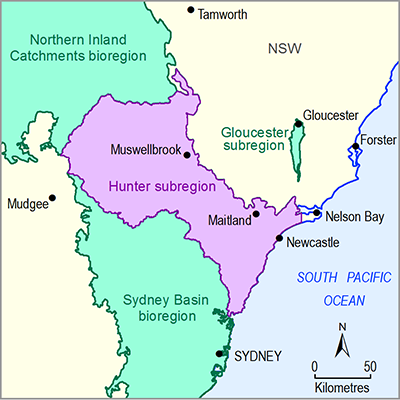- Home
- Assessments
- Bioregional Assessment Program
- Hunter subregion
- 2.6.2 Groundwater numerical modelling for the Hunter subregion
- 2.6.2.6 Parameterisation
- 2.6.2.6.3 Summary of parameters in the groundwater model
There are 22 parameters in the groundwater model. They can be broadly grouped by model function into parameters relating to:
- Land-surface fluxes: two fixed parameters for defining evapotranspiration processes (see Section 2.6.2.4.2); there is also a recharge multiplier used in the uncertainty analysis to vary the recharge input.
- General-head boundary behaviour: one fixed parameter that is the conductance of all lateral boundaries (except the boundary to the Werrie Basin) and the ocean floor.
- Surface water – groundwater fluxes: four parameters that define the boundary conditions for the movement of water from groundwater to the river. River stage height varies with riverbed depth. The two leakage limiter parameters are fixed in the model (see Section 2.6.2.4.3).
- Hydraulic properties: nine parameters to define porosities and vertical and horizontal hydraulic conductivities with depth for the interburden (lithologies 1 to 6) and the alluvium (lithology 7) (Section 2.6.2.6.1).
- Unsaturated flow: two fixed parameters in the van Genuchten unsaturated flow equation (Section 2.6.2.6.2).
- Hydraulic enhancement: four parameters to characterise the magnitude of and depth over which hydraulic conductivity changes occur due to longwall mining (see Section 2.6.2.6.3).
Table 7 summarises the groundwater model parameters, including the reference values, ranges over which parameters are varied in the uncertainty analysis (see Section 2.6.2.8) and salient points. As identified above, a number of these parameters are dealt with in other sections of this product.
The range of conductivity and porosity values explored in the uncertainty analysis and its comparison with measured data is shown in Figure 26 and Figure 31 of companion product 2.1-2.2 for the Hunter subregion (Herron et al., 2018). As mentioned above, an upscaling analysis may be performed to yield a probability distribution for hydraulic conductivity, and the result of such an analysis is shown in Figure 21, which motivates the uncertainty bounds in Table 7. Figure 21 shows the probability distribution for the measured data in the depth interval 0 to 100 m. In this interval, conductivity measurements vary between 10–7 m/day and 30 m/day. The data have been binned into nine bins: the first lies between 10–7 m/day and 10–6 m/day, the second between 10–6 m/day and 10–5 m/day, and so on up to between 101 m/day and 102 m/day. Figure 21 shows that the data are roughly uniformly distributed into these bins, with slightly more likelihood of measurements occurring in the central bins than in the outer bins. Figure 21 also contains a probability distribution for the upscaled conductivity that is derived from the measured data, and its comparison with the uncertainty bounds for a 50 m depth from Table 7. Upscaling is discussed further in Renard and de Marsily (1997).
Conductivity enhancement above and below mines is discussed in Section 2.6.2.5.3, and the wide range of variation (5 orders of magnitude, and heights ranging between 100 m and 500 m above longwall workings) reflects the wide variation that may be experienced in different mining scenarios (Adhikary and Wilkins, 2012; Guo et al., 2014).
Table 7 Groundwater model parameters: their reference values and the minimum and maximum values used in the uncertainty analysis
BP = bord-and-pillar; E = ephemeral; ET = evapotranspiration; GW = groundwater; PET = potential evapotranspiration; P = perennial; LW = longwall; na = not applicable; OC = open-cut; SW = surface water

Product Finalisation date
- 2.6.2.1 Methods
- 2.6.2.2 Review of existing models
- 2.6.2.3 Model development
- 2.6.2.4 Boundary and initial conditions
- 2.6.2.5 Implementation of the coal resource development pathway
- 2.6.2.6 Parameterisation
- 2.6.2.7 Observations and predictions
- 2.6.2.8 Uncertainty analysis
- 2.6.2.9 Limitations and conclusions
- Citation
- Acknowledgements
- Currency of scientific results
- Contributors to the Technical Programme
- About this technical product

